There’s never been a better time to start an e-commerce business. Sales are only going up, and the types of products and services you can find online has never been greater. If you’re the enterprising, passionate and ambitious kind, you’re probably thinking about how to get in on all that e-commerce goodness.
But where do you begin? Trying to start an e-commerce business takes a lot of research, planning and patience. But it can also be a seriously fun, exciting and creative project. Here’s an outline of 8 steps for helping you (and your team) develop, launch and promote a startup e-commerce business.
Find your product or idea
You need one to start an e-commerce business, and thankfully, there are lots of choices out there. Just know that competition is heavy, even in the world of e-commerce. Trying to muscle in on the territory of the big guys can be tough, especially as a startup.
That’s why you should go niche. Love shoes? Concentrate on selling a specific style (like men’s boots) or a specific accessory (like custom or patterned laces). The more you can home in one thing, the more you’ll stand out in the online shopping landscape.
Figure out your inventory model
Will you make products yourself (such as handmade jewelry)? Will you order from suppliers (such as big-name fashion brands)? Or will you have a manufacturer create a product you designed yourself (such as a card game or a line of watches)?
Choose your business name
This is a big one, isn’t it? You need a name that stands out, tells customers about your brand, but also leaves room for potential expansion in the future. So, take your time on this part and make sure you find a name that fits (some startups take months to settle on the perfect one).
There are plenty of businesses out there, meaning plenty of names are taken. Make sure you have at least 3 names you’re happy with, just in case 1 or 2 of them are already taken.
Decide on your business type
Will you be a self-proprietorship, starting out small and keeping personal control? Will you form a partnership with a friend or colleague and build something together? Or will you form a corporation or limited liability company (LLC) and aim for a sizeable business?
Secure your business identity
Register your business with the government and file for any permits, licenses or business numbers your particular efforts will need. Once that’s done, buy your website address, and sign up for the appropriate social media accounts.
It’s a good idea to research trademarks, website address names and social media handles while deciding on your business name. This way you’ll know, before registering your business, if someone’s taken the name or spelling that you prefer.
Select an e-commerce platform
Internet and commerce technology can be complicated. You have to think about site speed, appearance, security and so much more. Sure, if you have a big team, you can start an e-commerce business from the ground up. But if you’re just starting out with a small team (maybe it’s just you!), there are e-commerce platforms that take care of the foundation for you.
Research here is key. You’ll need to look at the major players out there and see how their features lists and pricing schemes work for you. Some platforms want you to pay more for better features, and some want a bigger cut of your revenue as your business grows. Choose what fits your business model.
Develop your marketing and promotions
You’ll need to be your biggest, loudest fan when you start. Tell your family, friends and co-workers when you start an e-commerce business. Go to trade shows or networking events. And that’s just offline marketing tactics.
Build an email list and tell followers and shoppers about new promotions and products. Use automated campaigns to keep them coming back—like abandoned cart emails that remind them to finish checking out. Find what social media channels work best with your products and audience, sharing content they’ll appreciate, and promotions they can’t resist.
Then invest in paid online marketing, both on your chosen social media channels and your search engine of choice (you all know the one we’re talking about!). The earlier you start your marketing efforts (both online and offline), the better.
You’ve got to spend money to make money. But you’ve also got to get people to like you, too.
Plan your shipping packaging
Every day, there are tons of customer orders out for delivery. With smart marketing and hard work, your own customer orders will soon join in on that delivery frenzy, so it’s important to be ready for it.
Your packaging strategy should aim for 3 things. It should (1) protect your products properly, (2) minimize dimensional weight shipping costs, and (3) help your orders stand out in the sea of kraft corrugated boxes.
You can satisfy all those points by (1) buying new, undamaged packaging supplies, (2) researching the potential of mailer envelopes and corrugated mailers, and (3) designing custom packaging. If the potential costs of custom branded packaging make you wary, remember that something as simple as a strip of custom packing tape or a custom printed label is all it takes to brand your shipments memorably.
So now, you should be in great shape to start an e-commerce business, promote it, and bask in the glow of all that success. Just remember that any business endeavour (or any endeavour really, right?) takes time, faith and commitment. Treat your online store like it’s a physical business—you wouldn’t run a physical store merely in your spare time, would you? Show it the attention it deserves, and it’ll reward you wonderfully in return.




